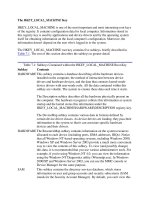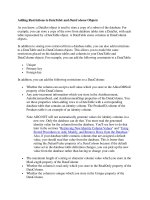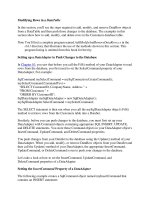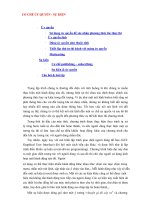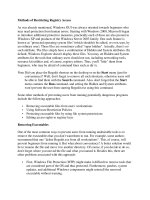Handbook of Positive Psychology Phần 1 ppt
Bạn đang xem bản rút gọn của tài liệu. Xem và tải ngay bản đầy đủ của tài liệu tại đây (418.16 KB, 76 trang )
Handbook of Positive
Psychology
C. R. Snyder
Shane J. Lopez,
Editors
OXFORD UNIVERSITY PRESS
HANDBOOK OF POSITIVE PSYCHOLOGY
This page intentionally left blank
HANDBOOK OF
POSITIVE PSYCHOLOGY
Edited by
C. R. Snyder
Shane J. Lopez
1
2002
1
Oxford New York
Athens Auckland Bangkok Bogota´ Buenos Aires Cape Town
Chennai Dar es Salaam Delhi Florence Hong Kong Istanbul Karachi
Kolkata Kuala Lumpur Madrid Melbourne Mexico City Mumbai Nairobi
Paris Sa˜o Paulo Shanghai Singapore Taipei Tokyo Toronto Warsaw
and associated companies in
Berlin Ibadan
Copyright ᭧ 2002 by Oxford University Press
Published by Oxford University Press, Inc.
198 Madison Avenue, New York, New York 10016
Oxford is a registered trademark of Oxford University Press
All rights reserved. No part of this publication may be reproduced,
stored in a retrieval system, or transmitted, in any form or by any means,
electronic, mechanical, photocopying, recording, or otherwise,
without the prior permission of Oxford University Press.
Library of Congress Cataloging-in-Publication Data
Handbook of positive psychology / edited by C. R. Snyder and Shane J. Lopez.
p. cm.
Includes bibliographical references and indexes.
ISBN 0–19–513533–4
1. Psychology. 2. Health. 3. Happiness. 4. Optimism.
I. Snyder, C. R. II. Lopez, Shane J.
BF121 6.H212 2002
150.19'8—dc21 2001021584
135798642
Printed in the United States of America
on acid-free paper
To the positive in all of us
This page intentionally left blank
Foreword
It gives me great joy to know that so many sci-
entists—many of whom have contributed to
this landmark volume—are striving to inspire
people to develop a more wholesome focus on
the positive aspects of life. I am convinced that
one day these scientists will be recognized as
visionary leaders, whose research helped to
identify, elevate, and celebrate the creative po-
tential of the human spirit.
Until recently, I had rarely heard about sci-
entific research that examined the life-
enhancing power of “spiritual principles”—pos-
itive character traits and virtues such as love,
hope, gratitude, forgiveness, joy, future-
mindedness, humility, courage, and noble pur-
pose. Perhaps my long-standing interest in
these spiritual principles and character traits is
best understood by sharing with you the fol-
lowing perspective. My grandfather was a phy-
sician during the Civil War, and several of my
own children are physicians today. I think we
would all agree that my children, because of the
enormous number of dollars earmarked for
medical research during this past century, know
a hundred times—perhaps a thousand times—
more about the human body than my grand-
father ever did. But I have always wondered:
Why is it that we know so little about the hu-
man spirit?
The research highlighted in this volume pro-
vides overwhelming evidence that many tal-
ented scholars and award-winning researchers
are reclaiming what was once at the core of their
discipline: the psyche, the study and under-
standing of the power of the human spirit to
benefit from life’s challenges. The men and
women who have written chapters for this
handbook, as well as countless more inspired by
their research, are courageously gathering data
and testing hypotheses to help us learn more
about an essential question that perhaps serves
as the North Star for a positive psychology:
What enables us to override our biological in-
clinations to be selfish and instead find meaning,
purpose, and value in nurturing and upholding
the positive qualities of our human nature?
In fact, I am more optimistic than ever that
one day soon a group of scientists will publish
findings that will advance humankind’s under-
standing of a spiritual principle that has been at
the core of my own life’s purpose: agape love.
One of my favorite sayings is, “Love hoarded
dwindles, but love given grows.” Love is more
powerful than money; unlike money, the more
love we give away, the more we have left. Per-
haps, dear reader, you will be the researcher who
studies a spiritual principle such as agape love
scientifically or empirically. Wouldn’t all of hu-
mankind benefit from knowing more about this
fundamental “law of life,” and many others?
Finally, I am hopeful that as current and fu-
ture researchers catch the vision of a positive
psychology, and as foundations and govern-
ments initiate programs to support this ground-
breaking and beneficial work, we will all forge
ahead in a spirit of humility. We know so little,
my friends, about the many gifts that God has
given to each and every human being. As the
truly wise tell us, “How little we know, how
eager to learn.”
Radnor, Pennsylvania Sir John Templeton
This page intentionally left blank
Preface
How often does one have the opportunity to
edit the first handbook for a new approach to
psychology? We had a “once-in-a-lifetime”
scholarly adventure in preparing this Handbook
of Positive Psychology. There was never a ques-
tion in our minds about editing this volume.
We were at the right place at the right time,
and the book simply had to happen.
Fortunately, our superb editors at Oxford
University Press, Joan Bossert and Catharine
Carlin, shared our enthusiasm about the neces-
sity of this volume, and they made this huge
editorial undertaking seamless in its unfolding.
The authors we invited to write chapters readily
agreed. Much to our delight, this handbook al-
most took on a life of its own. We attribute this
to the vitality of the authors, along with the
power of their positive psychology ideas and
science.
We complemented each other as an editorial
team. Snyder was a stickler for detail and yet
sought ingenuity in thought and expression.
Lopez saw linkages in ideas, would call upon the
related literatures, and brought unbridled en-
thusiasm to the editorial process. What this
combination produced was a line-by-line anal-
ysis and feedback in every chapter. In short, we
were “hands-on” editors. Given the stature
of the contributing scholars, with numerous
awards, distinguished professorships, and
honorary degrees, they certainly could have
balked at such editorial scrutiny. But they did
not. Instead, they used our feedback and revised
their already superb first drafts into stellar
subsequent chapters. We are indebted to this
remarkable group of authors for their patience
in this process. Their dedication to excel-
lence can be seen in the chapters of this hand-
book.
In order to help readers in gaining a sense of
the topics contained in each chapter, we have
asked our expert authors to identify sources that
provide excellent overviews of their areas.
Therefore, in the reference section of each chap-
ter, the authors have placed an asterisk in front
of such key readings. We encourage our readers
to use these background sources when more de-
tailed descriptions of a topic are desired.
Now, before you peruse the contributions of
the outstanding scholars, consider the following
. . . Imagine a planet where the inhabitants are
self-absorbed, hopeless, and filled with psycho-
logical problems and weaknesses. Confusion,
anxiety, fear, and hostility race through their
minds. These creatures “communicate” with
each other by lying, faking, torturing, fighting,
and killing. They hurt each other, and they hurt
themselves. Of course, this imaginary planet is
not far away—we call it Earth. Although these
problems do exist, they are made to loom even
larger because of the propensities of psychology
and its sister disciplines to focus on the weak-
nesses in humankind. Now let us imagine an-
other planet where the inhabitants are caring,
hopeful, and boundless in their psychological
strengths. Their thoughts and feelings are clear,
focused, and tranquil. These creatures commu-
nicate by spending time talking and listening to
each other. They are kind to each other and to
themselves. Again, this imaginary, not-so-far-
x PREFACE
away planet is Earth. These positive descriptions
aptly fit many of the people on Earth. In this
regard, hardly anyone (including some cynics)
quibbles with this latter conclusion. But no sci-
ence, including psychology, looks seriously at
this positive side of people. It is this latter trou-
bling void that positive psychology addresses.
As such, this handbook provides an initial sci-
entific overview of the positive in humankind.
As with any new and promising paradigm, the
reactions of people such as you will determine
the fate of positive psychology. Although sci-
ence certainly advances on the merits of partic-
ular ideas and facts, it also is true that the suc-
cess of a new theory rests, in part, upon its
ability to gather supporters. On this point, this
handbook may enable you to cast a more in-
formed vote as to the enduring viability of pos-
itive psychology.
Lawrence, Kansas C. R. Snyder
Shane J. Lopez
Contents
Contributors, xv
PART I. INTRODUCTORY AND HISTORICAL
OVERVIEW
1 Positive Psychology, Positive Prevention,
and Positive Therapy, 3
martin e. p. seligman
PART II. IDENTIFYING STRENGTHS
2 Stopping the “Madness”: Positive
Psychology and the Deconstruction of the
Illness Ideology and the DSM,13
james e. maddux
3 Widening the Diagnostic Focus: A Case
for Including Human Strengths and
Environmental Resources, 26
beatrice a. wright
shane j. lopez
4 Toward a Science of Mental Health:
Positive Directions in Diagnosis and
Interventions, 45
corey l. m. keyes
shane j. lopez
PART III. EMOTION-FOCUSED APPROACHES
5 Subjective Well-Being: The Science of
Happiness and Life Satisfaction, 63
ed diener
richard e. lucas
shigehiro oishi
6 Resilience in Development, 74
ann s. masten
marie-gabrielle j. reed
7 The Concept of Flow, 89
jeanne nakamura
mihaly csikszentmihalyi
8 Positive Affectivity: The Disposition to
Experience Pleasurable Emotional
States, 106
david watson
9 Positive Emotions, 120
barbara l. fredrickson
10 The Social Construction of Self-
Esteem, 135
john p. hewitt
11 The Adaptive Potential of Coping
Through Emotional Approach, 148
annette l. stanton
anita parsa
jennifer l. austenfeld
xii CONTENTS
12 The Positive Psychology of Emotional
Intelligence, 159
peter salovey
john d. mayer
david caruso
13 Emotional Creativity: Toward
“Spiritualizing the Passions”, 172
james r. averill
PART IV. COGNITIVE-FOCUSED APPROACHES
14 Creativity, 189
dean keith simonton
15 The Role of Personal Control in Adaptive
Functioning, 202
suzanne c. thompson
16 Well-Being: Mindfulness Versus Positive
Evaluation, 214
ellen langer
17 Optimism, 231
charles s. carver
michael f. scheier
18 Optimistic Explanatory Style, 244
christopher peterson
tracy a. steen
19 Hope Theory: A Member of the Positive
Psychology Family, 257
c. r. snyder
kevin l. rand
david r. sigmon
20 Self-Efficacy: The Power of Believing You
Can, 277
james e. maddux
21 Problem-Solving Appraisal and
Psychological Adjustment, 288
p. paul heppner
doug-gwi lee
22 Setting Goals for Life and
Happiness, 299
edwin a. locke
23 The Passion to Know: A Developmental
Perspective, 313
michael schulman
24 Wisdom: Its Structure and Function in
Regulating Successful Life Span
Development, 327
paul b. baltes
judith glu¨ ck
ute kunzmann
PART V. SELF-BASED APPROACHES
25 Reality Negotiation, 351
raymond l. higgins
26 The Truth About Illusions: Authenticity
and Positivity in Social
Relationships, 366
william b . swann
brett w. pelham
27 Authenticity, 382
susan harter
28 Uniqueness Seeking, 395
michael lynn
c. r. snyder
29 Humility, 411
june price tangney
PART VI. INTERPERSONAL APPROACHES
30 Relationship Connection: The Role of
Minding in the Enhancement of
Closeness, 423
john h. harvey
brian g. pauwels
susan zickmund
31 Compassion, 434
eric j. cassell
32 The Psychology of Forgiveness, 446
michael e. mccullough
charlotte vanoyen witvliet
33 Gratitude and the Science of Positive
Psychology, 459
robert a. emmons
charles m. shelton
CONTENTS xiii
34 Love, 472
susan hendrick
clyde hendrick
35 Empathy and Altruism, 485
c. daniel batson
nadia ahmad
david a. lishner
jo-ann tsang
36 How We Become Moral: The Sources of
Moral Motivation, 499
michael schulman
PART VII. BIOLOGICAL APPROACHES
37 Toughness, 515
richard a. dienstbier
lisa m. pytlik zillig
38 A Role for Neuropsychology in
Understanding the Facilitating Influence of
Positive Affect on Social Behavior and
Cognitive Processes, 528
alice m. isen
39 From Social Structure to Biology:
Integrative Science in Pursuit of Human
Health and Well-Being, 541
carol d. ryff
burton singer
40 Toward a Biology of Social Support, 556
shelley e. taylor
sally s. dickerson
laura cousino klein
PART VIII. SPECIFIC COPING APPROACHES
41 Sharing One’s Story: On the Benefits of
Writing or Talking About Emotional
Experience, 573
kate g. niederhoffer
james w. pennebaker
42 Benefit-Finding and Benefit-
Reminding, 584
howard tennen
glenn affleck
43 Positive Responses to Loss: Perceiving
Benefits and Growth, 598
susan nolen-hoeksema
christopher g. davis
44 The Pursuit of Meaningfulness in
Life, 608
roy f. baumeister
kathleen d. vohs
45 Humor, 619
herbert m. lefcourt
46 Meditation and Positive Psychology, 632
shauna l. shapiro
gary e. r. schwartz
craig santerre
47 Spirituality: Discovering and Conserving
the Sacred, 646
kenneth i. pargament
annette mahoney
PART IX. SPECIAL POPULATIONS AND
SETTINGS
48 Positive Psychology for Children:
Development, Prevention, and
Promotion, 663
michael c. roberts
keri j. brown
rebecca j. johnson
janette reinke
49 Aging Well: Outlook for the 21st
Century, 676
gail m. williamson
50 Positive Growth Following Acquired
Physical Disability, 687
timothy r. elliott
monica kurylo
patricia rivera
51 Putting Positive Psychology in a
Multicultural Context, 700
shane j. lopez
ellie c. prosser
lisa m. edwards
jeana l. magyar-moe
jason e. neufeld
heather n. rasmussen
xiv CONTENTS
52 Positive Psychology at Work, 715
nick turner
julian barling
anthea zacharatos
PART X. THE FUTURE OF THE FIELD
53 Positive Ethics, 731
mitchell m. handelsman
samuel knapp
michael c. gottl ieb
54 Constructivism and Positive
Psychology, 745
michael j. mahoney
55 The Future of Positive Psychology: A
Declaration of Independence, 751
c. r. snyder
shane j. lopez
with contributions from
Lisa Aspinwall
Barbara L. Fredrickson
Jon Haidt
Dacher Keltner
Christine Robitschek
Michael Wehmeyer
Amy Wrzesniewski
Author Index, 769
Subject Index, 793
xvi CONTRIBUTORS
TIMOTHY R
.
ELLIOTT
, Associate Professor
and Psychologist, Department of Physical
Medicine and Rehabilitation, University of
Alabama–Birmingham Medical School
ROBERT A
.
EMMONS
, Professor, Department
of Psychology, University of California, Da-
vis
BARBARA L
.
FREDRICKSON
, Associate Pro-
fessor, Department of Psychology, Univer-
sity of Michigan
JUDITH GLECK
, Max Planck Institute for Hu-
man Development, Berlin, Germany
MICHAEL C
.
GOTTLIEB
, Private Practice,
Dallas, Texas
JON HAIDT
, Assistant Professor, Department
of Psychology, University of Virginia, Char-
lottesville
MITCHELL M
.
HANDELSMAN
, Professor of
Psychology and Colorado University Presi-
dent’s Teaching Scholar, Department of
Psychology, University of Colorado
SUSAN HARTER
, Professor, Department of
Psychology, University of Denver
JOHN H
.
HARVEY
, Professor, Department of
Psychology, University of Iowa
CLYDE HENDRICK
, Paul Whitfield Horn Pro-
fessor of Psychology, Department of Psy-
chology, Texas Tech University
SUSAN HENDRICK
, Associate Dean, College
of Arts and Sciences, and Professor, Depart-
ment of Psychology, Texas Tech University
P
.
PAUL HEPPNER
, Professor, Department of
Educational and Counseling Psychology,
University of Missouri–Columbia
JOHN P
.
HEWITT
, Professor, Department of
Sociology, University of Massachusetts,
Amherst
RAYMOND L
.
HIGGINS
, Professor, Clinical
Psychology Program, Department of Psy-
chology, University of Kansas
ALICE M
.
ISEN
, Samuel Curtis Johnson Pro-
fessor of Marketing and Professor of Behav-
ioral Science, Johnson Graduate School of
Management and Department of Psychol-
ogy, Cornell University
REBECCA J
.
JOHNSON
, Doctoral Student,
Clinical Child Psychology, Departments of
Psychology and Human Development and
Family Life, University of Kansas
DACHER KELTNER
, Associate Professor, De-
partment of Psychology, University of Cali-
fornia, Berkeley
COREY L
.
M
.
KEYES
, Assistant Professor,
Department of Sociology and the Rollins
School of Public Health, Emory University
LAURA COUSINO KLEIN
, Department of
Biobehavioral Health, Pennsylvania State
University
SAMUEL KNAPP
, Director of Professional Af-
fairs, Pennsylvania Psychological Associa-
tion
UTE KUNZMANN
, Max Planck Institute for
Human Development, Berlin, Germany
MONICA KURYLO
, Rehabilitation Psycholo-
gist, Department of Physical Medicine and
Rehabilitation, University of Alabama–
Birmingham Medical School
ELLEN LANGER
, Professor, Department of
Psychology, Harvard University
DOUG
-
GWI LEE
, Doctoral Student, Counsel-
ing Psychology Program, Department of Ed-
ucational and Counseling Psychology, Uni-
versity of Missouri–Columbia
HERBERT M
.
LEFCOURT
, Distinguished Pro-
fessor Emeritus, Department of Psychology,
University of Waterloo
DAVID A
.
LISHNER
, Doctoral Student, Social
Psychology Program, Department of Psy-
chology, University of Kansas
EDWIN A
.
LOCKE
, Dean’s Professor Emeritus
of Leadership and Motivation, R. H. Smith
School of Business, University of Maryland,
College Park
SHANE J
.
LOPEZ
, Assistant Professor, Coun-
seling Psychology Program, Department of
Psychology and Research in Education, Uni-
versity of Kansas
RICHARD E
.
LUCAS
, Assistant Professor, De-
partment of Psychology, Michigan State
University
MICHAEL LYNN
, Professor, School of Hotel
Administration, Cornell University
JAMES E
.
MADDUX
, Professor and Associate
Chair for Graduate Studies, Department of
Psychology, George Mason University
CONTRIBUTORS xvii
JEANA L
.
MAGYAR
-
MOE
, Doctoral Student,
Counseling Psychology Program, Depart-
ment of Psychology and Research in Educa-
tion, University of Kansas
ANNETTE MAHONEY
, Associate Professor,
Department of Psychology, Bowling Green
State University
MICHAEL J
.
MAHONEY
, Professor, Clinical
Psychology Program, Department of Psy-
chology, University of North Texas
ANN S
.
MASTEN
, Director, Institute of Child
Development, and Emma M. Birkmaier Pro-
fessor in Educational Leadership, University
of Minnesota
JOHN D
.
MAYER
, Professor of Psychology,
Department of Psychology, University of
New Hampshire
MICHAEL E
.
MCCULLOUGH
, Associate Pro-
fessor, Department of Psychology, Southern
Methodist University
JEANNE NAKAMURA
, Research Director,
Quality of Life Research Center, Claremont
Graduate University
JASON E
.
NEUFELD
, Doctoral Student, Coun-
seling Psychology Program, Department of
Psychology and Research in Education, Uni-
versity of Kansas
KATE G
.
NIEDERHOFFER
, Doctoral Student,
Social Psychology Program, Department of
Psychology, University of Texas
SUSAN NOLEN
-
HOEKSEMA
, Professor, De-
partment of Psychology, University of
Michigan
SHIGEHIRO OISHI
, Assistant Professor, De-
partment of Psychology, University of Min-
nesota
KENNETH I
.
PARGAMENT
, Professor, De-
partment of Psychology, Bowling Green
State University
ANITA PARSA
, Doctoral Student, Clinical
Psychology Program, Department of Psy-
chology, University of Kansas
BRIAN G
.
PAUWELS
, Doctoral Student, Per-
sonality and Social Psychology, Department
of Psychology, University of Iowa
BRETT W
.
PELHAM
, Associate Professor, De-
partment of Psychology, State University of
New York at Buffalo
JAMES W
.
PENNEBAKER
, Professor, Depart-
ment of Psychology, University of Texas
CHRISTOPHER PETERSON
, Professor of Psy-
chology and Arthur F. Thurnau Professor,
Clinical Psychology Program, University of
Michigan
ELLIE C
.
PROSSER
, Doctoral Student, Coun-
seling Psychology Program, Department of
Psychology and Research in Education, Uni-
versity of Kansas
KEVIN L
.
RAND
, Doctoral Student, Clinical
Psychology Program, Department of Psy-
chology, University of Kansas
HEATHER N
.
RASMUSSEN
, Doctoral Student,
Counseling Psychology Program, Depart-
ment of Psychology and Research in Educa-
tion, University of Kansas
MARIE
-
GABRIELLE J
.
REED
, Research Assis-
tant, Institute of Child Development, Uni-
versity of Minnesota
JANNETTE REINKE
, Doctoral Student, Clinical
Child Psychology, Departments of Psychol-
ogy and Human Development and Family
Life, University of Kansas
PATRICIA RIVERA
, Postdoctoral Fellow, De-
partment of Physical Medicine and Rehabili-
tation, University of Alabama–Birmingham
Medical School
MICHAEL C
.
ROBERTS
, Professor and Direc-
tor, Clinical Child Psychology Program,
University of Kansas
CHRISTINE ROBITSCHEK
, Associate Profes-
sor, Counseling Psychology Program, De-
partment of Psychology, Texas Tech Uni-
versity
CAROL D
.
RYFF
, Director, Institute on Aging
and Professor of Psychology, Department of
Psychology, University of Wisconsin, Madi-
son
PETER SALOVEY
, Professor of Psychology
and of Epidemiology and Public Health, De-
partment of Psychology, Yale University
CRAIG SANTERRE
, Doctoral Student, Clinical
Psychology Program, Department of Psy-
chology, University of Arizona
MICHAEL F
.
SCHEIER
, Professor, Department
of Psychology, Carnegie-Mellon University
xviii CONTRIBUTORS
MICHAEL SCHULMAN
, Clinical Department,
Leake and Watts Services, Bronx, New York
GARY E
.
R
.
SCHWARTZ
, Professor of Psy-
chology, Neurology, Psychiatry, and Medi-
cine, Director, Human Energy Systems Lab,
Department of Psychology, University of
Arizona
MARTIN E
.
P
.
SELIGMAN
, Fox Leadership
Professor of Psychology, Department of
Psychology, University of Pennsylvania
SHAUNA L
.
SHAPIRO
, Doctoral Student,
Clinical Psychology Program, Department of
Psychology, University of Arizona
CHARLES M
.
SHELTON
, Professor of Psy-
chology, Department of Psychology, Regis
University
DAVID R
.
SIGMON
, Doctoral Student, Clini-
cal Psychology Program, Department of
Psychology, University of Kansas
DEAN KEITH SIMONTON
, Professor, Depart-
ment of Psychology, University of Califor-
nia, Davis
BURTON SINGER
, Professor of Demography
and Public Affairs and the Charles and Ma-
rie Robertson Professor of Public and Inter-
national Affairs, Office of Population Re-
search, Princeton University
C
.
R
.
SNYDER
, M. Erik Wright Distinguished
Professor of Clinical Psychology, Depart-
ment of Psychology, University of Kansas
ANNETTE L
.
STANTON
, Professor, Clinical
Psychology Program, Department of Psy-
chology, University of Kansas
TRACY A
.
STEEN
, Doctoral Student, Clinical
Psychology Program, Department of Psy-
chology, University of Michigan
WILLIAM B
.
SWANN
, William Howard Beas-
ley Professor, Department of Psychology,
University of Texas
JUNE PRICE TANGNEY
, Professor, Depart-
ment of Psychology, James Madison Uni-
versity
SHELLEY E
.
TAYLOR
, Professor, Department
of Psychology, University of California, Los
Angeles
SIR JOHN TEMPLETON
, Founder of Temple-
ton Foundation, Radnor Pennsylvania
HOWARD TENNEN
, Professor, Department of
Psychiatry, University of Connecticut
Health Center
SUZANNE C
.
THOMPSON
, Professor, Depart-
ment of Psychology, Pomona College
JO
-
ANN TSANG
, Postdoctoral Fellow, Depart-
ment of Psychology, Southern Methodist
University
NICK TURNER
, Doctoral Student, Institute of
Work Psychology, The University of Shef-
field
KATHLEEN D
.
VOHS
, Postdoctoral Fellow,
Department of Psychology, Case Western
Reserve University
DAVID WATSON
, Professor, Department of
Psychology, University of Iowa
MICHAEL WEHMEYER
, Courtesy Associate
Professor, Special Education Department,
University of Kansas
GAIL M
.
WILLIAMSON
, Professor and Chair,
Life-Span Developmental Psychology, De-
partment of Psychology, University of
Georgia
CHARLOTTE VANOYEN WITVLIET
, Associate
Professor, Department of Psychology, Hope
College
BEATRICE A
.
WRIGHT
, Professor Emerita,
University of Kansas
AMY WRZESNIEWSKI
, Assistant Professor,
Department of Management and Organiza-
tional Behavior, New York University
ANTHEA ZACHARATOS
, Doctoral Student,
School of Business, Queen’s University,
Kingston, Ontario, Canada
SUSAN ZICKMUND
, Assistant Professor, De-
partment of Internal Medicine, University
of Iowa College of Medicine
LISA M
.
PYTLIK ZILLIG
, Doctoral Student,
Clinical Psychology Program, Department of
Psychology, University of Nebraska
This page intentionally left blank
4 PART I. INTRODUCTORY AND HISTORICAL OVERVIEW
done. And if I can stop whining, you can stop
being such a grouch.”
This was for me an epiphany, nothing less. I
learned something about Nikki, something
about raising kids, something about myself, and
a great deal about my profession. First, I real-
ized that raising Nikki was not about correcting
whining. Nikki did that herself. Rather, I real-
ized that raising Nikki was about taking this
marvelous skill—I call it “seeing into the
soul”—and amplifying it, nurturing it, helping
her to lead her life around it to buffer against
her weaknesses and the storms of life. Raising
children, I realized, is more than fixing what is
wrong with them. It is about identifying and
nurturing their strongest qualities, what they
own and are best at, and helping them find
niches in which they can best live out these pos-
itive qualities.
As for my own life, Nikki hit the nail right
on the head. I was a grouch. I had spent 50
years mostly enduring wet weather in my soul,
and the last 10 years being a nimbus cloud in a
household of sunshine. Any good fortune I had
was probably not due to my grouchiness but in
spite of it. In that moment, I resolved to change.
But the broadest implication of Nikki’s lesson
was about the science and practice of psychol-
ogy. Before World War II, psychology had
three distinct missions: curing mental illness,
making the lives of all people more productive
and fulfilling, and identifying and nurturing
high talent. Right after the war, two events—
both economic—changed the face of psychol-
ogy. In 1946, the Veterans Administration was
founded, and thousands of psychologists found
out that they could make a living treating men-
tal illness. At that time the profession of clinical
psychologist came into its own. In 1947, the Na-
tional Institute of Mental Health (which was
based on the American Psychiatric Association’s
disease model and is better described as the Na-
tional Institute of Mental Illness) was founded,
and academics found out that they could get
grants if their research was described as being
about pathology.
This arrangement brought many substantial
benefits. There have been huge strides in the
understanding of and therapy for mental illness:
At least 14 disorders, previously intractable,
have yielded their secrets to science and can
now be either cured or considerably relieved
(Seligman, 1994). But the downside was that the
other two fundamental missions ofpsychology—
making the lives of all people better and nur-
turing genius—were all but forgotten. It was
not only the subject matter that altered with
funding but also the currency of the theories
underpinning how we viewed ourselves. Psy-
chology came to see itself as a mere subfield of
the health professions, and it became a victim-
ology. We saw human beings as passive foci:
stimuli came on and elicited responses (what an
extraordinarily passive word). External rein-
forcements weakened or strengthened re-
sponses, or drives, tissue needs, or instincts.
Conflicts from childhood pushed each of us
around.
Psychology’s empirical focus then shifted to
assessing and curing individual suffering. There
has been an explosion in research on psycho-
logical disorders and the negative effects of en-
vironmental stressors such as parental divorce,
death, and physical and sexual abuse. Practi-
tioners went about treating mental illness
within the disease-patient framework of repair-
ing damage: damaged habits, damaged drives,
damaged childhood, and damaged brains.
The message of the positive psychology
movement is to remind our field that it has been
deformed. Psychology is not just the study of
disease, weakness, and damage; it also is the
study of strength and virtue. Treatment is not
just fixing what is wrong; it also is building
what is right. Psychology is not just about ill-
ness or health; it also is about work, education,
insight, love, growth, and play. And in this
quest for what is best, positive psychology does
not rely on wishful thinking, self-deception, or
hand waving; instead, it tries to adapt what is
best in the scientific method to the unique prob-
lems that human behavior presents in all its
complexity.
Positive Prevention
What foregrounds this approach is the issue of
prevention. In the last decade psychologists
have become concerned with prevention, and
this was the theme of the 1998 American Psy-
chological Association meeting in San Francisco.
How can we prevent problems like depression
or substance abuse or schizophrenia in young
people who are genetically vulnerable or who
live in worlds that nurture these problems?
How can we prevent murderous schoolyard vi-
olence in children who have poor parental su-
CHAPTER 1. POSITIVE PREVENTION AND POSITIVE THERAPY 5
pervision, a mean streak, and access to weapons?
What we have learned over 50 years is that the
disease model does not move us closer to the
prevention of these serious problems. Indeed,
the major strides in prevention have largely
come from a perspective focused on systemati-
cally building competency, not correcting weak-
ness.
We have discovered that there are human
strengths that act as buffers against mental ill-
ness: courage, future-mindedness, optimism, in-
terpersonal skill, faith, work ethic, hope, hon-
esty, perseverance, the capacity for flow and
insight, to name several. Much of the task of
prevention in this new century will be to create
a science of human strength whose mission will
be to understand and learn how to foster these
virtues in young people.
My own work in prevention takes this ap-
proach and amplifies a skill that all individuals
possess but usually deploy in the wrong place.
The skill is called disputing (Beck, Rush, Shaw,
& Emery, 1979), and its use is at the heart of
“learned optimism.” If an external person, who
is a rival for your job, accuses you falsely of
failing at your job and not deserving your po-
sition, you will dispute him. You will marshal
all the evidence that you do your job very well.
You will grind the accusations into dust. But if
you accuse yourself falsely of not deserving
your job, which is just the content of the au-
tomatic thoughts of pessimists, you will not dis-
pute it. If it issues from inside, we tend to be-
lieve it. So in “learned optimism” training
programs, we teach both children and adults to
recognize their own catastrophic thinking and
to become skilled disputers (Peterson, 2000; Se-
ligman, Reivich, Jaycox, & Gillham, 1995; Se-
ligman, Schulman, DeRubeis, & Hollon, 1999).
This training works, and once you learn it, it
is a skill that is self-reinforcing. We have shown
that learning optimism prevents depression and
anxiety in children and adults, roughly halving
their incidence over the next 2 years. I mention
this work only in passing, however. It is in-
tended to illustrate the Nikki principle: that
building a strength, in this case, optimism, and
teaching people when to use it, rather than re-
pairing damage, effectively prevents depression
and anxiety. Similarly, I believe that if we wish
to prevent drug abuse in teenagers who grow
up in a neighborhood that puts them at risk, the
effective prevention is not remedial. Rather, it
consists of identifying and amplifying the
strengths that these teens already have. A teen-
ager who is future-minded, who is interperson-
ally skilled, who derives flow from sports, is not
at risk for substance abuse. If we wish to pre-
vent schizophrenia in a young person at genetic
risk, I would propose that the repairing of dam-
age is not going to work. Rather, I suggest that
a young person who learns effective interper-
sonal skills, who has a strong work ethic, and
who has learned persistence under adversity is
at lessened risk for schizophrenia.
This, then, is the general stance of positive
psychology toward prevention. It claims that
there is a set of buffers against psychopathol-
ogy: the positive human traits. The Nikki prin-
ciple holds that by identifying, amplifying, and
concentrating on these strengths in people at
risk, we will do effective prevention. Working
exclusively on personal weakness and on dam-
aged brains, and deifying the Diagnostic and
Statistical Manual (DSM), in contrast, has ren-
dered science poorly equipped to do effective
prevention. We now need to call for massive
research on human strength and virtue. We
need to develop a nosology of human strength—
the “UNDSM-I”, the opposite of DSM-IV.We
need to measure reliably and validly these
strengths. We need to do the appropriate lon-
gitudinal studies and experiments to understand
how these strengths grow (or are stunted; Vail-
lant, 2000). We need to develop and test inter-
ventions to build these strengths.
We need to ask practitioners to recognize that
much of the best work they already do in the
consulting room is to amplify their clients’
strengths rather than repair their weaknesses.
We need to emphasize that psychologists work-
ing with families, schools, religious communi-
ties, and corporations develop climates that fos-
ter these strengths. The major psychological
theories now undergird a new science of
strength and resilience. No longer do the dom-
inant theories view the individual as a passive
vessel “responding” to “stimuli”; rather, indi-
viduals now are seen as decision makers, with
choices, preferences, and the possibility of be-
coming masterful, efficacious, or, in malignant
circumstances, helpless and hopeless. Science
and practice that relies on the positive psychol-
ogy worldview may have the direct effect of
preventing many of the major emotional dis-
orders. It also may have two side effects: mak-
ing the lives of our clients physically healthier,
given all we are learning about the effects of
6 PART I. INTRODUCTORY AND HISTORICAL OVERVIEW
mental well-being on the body; and reorienting
psychology to its two neglected missions, mak-
ing normal people stronger and more produc-
tive, as well as making high human potential
actual.
Positive Therapy
I am going to venture a radical proposition
about why psychotherapy works as well as it
does. I am going to suggest that positive psy-
chology, albeit intuitive and inchoate, is a major
effective ingredient in therapy as it is now done;
if it is recognized and honed, it will become an
even more effective approach to psychotherapy.
But before doing so, it is necessary to say what
I believe about “specific” ingredients in therapy.
I believe there are some clear specifics in psy-
chotherapy. Among them are
• Applied tension for blood and injury phobia
• Penile squeeze for premature ejaculation
• Cognitive therapy for panic
• Relaxation for phobia
• Exposure for obsessive-compulsive disorder
• Behavior therapy for enuresis
(My book What You Can Change and What
You Can’t [1994] documents the specifics and
reviews the relevant literature.) But specificity
of technique to disorder is far from the whole
story.
There are three serious anomalies on which
present specificity theories of the effectiveness
of psychotherapy stub their toes. First, effect-
iveness studies (field studies of real-world deliv-
ery), as opposed to laboratory efficacy studies of
psychotherapy, show a substantially larger ben-
efit of psychotherapy. In the Consumer Reports
study, for example, over 90% of respondents
reported substantial benefits, as opposed to
about 65% in efficacy studies of specific psy-
chotherapies (Seligman, 1995, 1996). Second,
when one active treatment is compared with an-
other active treatment, specificity tends to dis-
appear or becomes quite a small effect. Lester
Luborsky’s corpus and the National Collabora-
tive Study of Depression are examples. The lack
of robust specificity also is apparent in much of
the drug literature. Methodologists argue end-
lessly over flaws in such outcome studies, but
they cannot hatchet away the general lack of
specificity. The fact is that almost no psycho-
therapy technique that I can think of (with the
exceptions mentioned previously) shows big,
specific effects when it is compared with another
form of psychotherapy or drug, adequately ad-
ministered. Finally, add the seriously large “pla-
cebo” effect found in almost all studies of psy-
chotherapy and of drugs. In the depression
literature, a typical example, around 50% of pa-
tients will respond well to placebo drugs or
therapies. Effective specific drugs or therapies
usually add another 15% to this, and 75% of
the effects of antidepressant drugs can be ac-
counted for by their placebo nature (Kirsch &
Sapirstein, 1998).
So why is psychotherapy so robustly effec-
tive? Why is there so little specificity of psy-
chotherapy techniques or specific drugs? Why
is there such a huge placebo effect?
Let me speculate on this pattern of questions.
Many of the relevant ideas have been put for-
ward under the derogatory misnomer nonspe-
cifics. I am going to rename two classes of non-
specifics as tactics and deep strategies. Among
the tactics of good therapy are
• Attention
• Authority figure
• Rapport
• Paying for services
• Trust
• Opening up
• Naming the problem
• Tricks of the trade (e.g., “Let’s pause here,”
rather than “Let’s stop here”)
The deep strategies are not mysteries. Good
therapists almost always use them, but they do
not have names, they are not studied, and,
locked into the disease model, we do not train
our students to use them to better advantage. I
believe that the deep strategies are all tech-
niques of positive psychology and that they can
be the subject of large-scale science and of the
invention of new techniques that maximize
them. One major strategy is instilling hope
(Snyder, Ilardi, Michael, & Cheavens, 2000).
But I am not going to discuss this one now, as
it is often discussed elsewhere in the literature
on placebo, on explanatory style and hopeless-
ness, and on demoralization (Seligman, 1994).
Another is the “building of buffering
strengths,” or the Nikki principle. I believe that
it is a common strategy among almost all com-
petent psychotherapists to first identify and
then help their patients build a large variety of
strengths, rather than just to deliver specific
CHAPTER 1. POSITIVE PREVENTION AND POSITIVE THERAPY 7
damage-healing techniques. Among the
strengths built in psychotherapy are
• Courage
• Interpersonal skill
• Rationality
• Insight
• Optimism
• Honesty
• Perseverance
• Realism
• Capacity for pleasure
• Putting troubles into perspective
• Future-mindedness
• Finding purpose
Assume for a moment that the buffering effects
of strength-building strategies have a larger ef-
fect than the specific “healing” ingredients that
have been discovered. If this is true, the rela-
tively small specificity found when different ac-
tive therapies and different drugs are compared
and the massive placebo effects both follow.
One illustrative deep strategy is “narration.”
I believe that telling the stories of our lives,
making sense of what otherwise seems chaotic,
distilling and discovering a trajectory in our
lives, and viewing our lives with a sense of
agency rather than victimhood are all power-
fully positive (Csikszentmihalyi, 1993). I be-
lieve that all competent psychotherapy forces
such narration, and this buffers against mental
disorder in just the same way hope does. Notice,
however, that narration is not a primary subject
of research on therapy process, that we do not
have categories of narration, that we do not
train our students to better facilitate narration,
that we do not reimburse practitioners for it.
The use of positive psychology in psycho-
therapy exposes a fundamental blind spot in
outcome research: The search for empirically
validated therapies (EVTs) has in its present
form handcuffed us by focusing only on vali-
dating the specific techniques that repair dam-
age and that map uniquely into DSM-IV cate-
gories. The parallel emphasis in managed care
organizations on delivering only brief treat-
ments directed solely at healing damage may
rob patients of the very best weapons in the
arsenal of therapy—making our patients
stronger human beings. That by working in the
medical model and looking solely for the salves
to heal the wounds, we have misplaced much of
our science and much of our training. That by
embracing the disease model of psychotherapy,
we have lost our birthright as psychologists, a
birthright that embraces both healing what is
weak and nurturing what is strong.
Conclusions
Let me end this introduction to the Handbook
of Positive Psychology with a prediction about
the science and practice of psychology in the
21st century. I believe that a psychology of pos-
itive human functioning will arise that achieves
a scientific understanding and effective inter-
ventions to build thriving individuals, families,
and communities.
You may think that it is pure fantasy, that
psychology will never look beyond the victim,
the underdog, and the remedial. But I want to
suggest that the time is finally right. I well rec-
ognize that positive psychology is not a new
idea. It has many distinguished ancestors (e.g.,
Allport, 1961; Maslow, 1971). But they some-
how failed to attract a cumulative and empirical
body of research to ground their ideas.
Why did they not? And why has psychology
been so focused on the negative? Why has it
adopted the premise—without a shred of evi-
dence—that negative motivations are authentic
and positive emotions are derivative? There are
several possible explanations. Negative emo-
tions and experiences may be more urgent and
therefore override positive ones. This would
make evolutionary sense. Because negative
emotions often reflect immediate problems or
objective dangers, they should be powerful
enough to force us to stop, increase vigilance,
reflect on our behavior, and change our actions
if necessary. (Of course, in some dangerous sit-
uations, it will be most adaptive to respond
without taking a great deal of time to reflect.)
In contrast, when we are adapting well to the
world, no such alarm is needed. Experiences
that promote happiness often seem to pass ef-
fortlessly. So, on one level, psychology’s focus
on the negative may reflect differences in the
survival value of negative versus positive emo-
tions.
But perhaps we are oblivious to the survival
value of positive emotions precisely because
they are so important. Like the fish that is un-
aware of the water in which it swims, we take
for granted a certain amount of hope, love, en-
joyment, and trust because these are the very
conditions that allow us to go on living (Myers,
2000). They are the fundamental conditions of
8 PART I. INTRODUCTORY AND HISTORICAL OVERVIEW
existence, and if they are present, any amount
of objective obstacles can be faced with equa-
nimity, and even joy. Camus wrote that the
foremost question of philosophy is why one
should not commit suicide. One cannot answer
that question just by curing depression; there
must be positive reasons for living as well.
There also are historical reasons for psychol-
ogy’s negative focus. When cultures face mili-
tary threat, shortages of goods, poverty, or in-
stability, they may most naturally be concerned
with defense and damage control. Cultures may
turn their attention to creativity, virtue, and the
highest qualities in life only when they are sta-
ble, prosperous, and at peace. Athens during the
5th century b.c., Florence of the 15th century,
and England in the Victorian era are examples
of cultures that focused on positive qualities.
Athenian philosophy focused on the human vir-
tues: What is good action and good character?
What makes life most worthwhile? Democracy
was born during this era. Florence chose not to
become the most important military power in
Europe but to invest its surplus in beauty. Vic-
torian England affirmed honor, discipline, and
duty as important human virtues.
I am not suggesting that our culture should
now erect an aesthetic monument. Rather, I be-
lieve that our nation—wealthy, at peace, and
stable—provides a similar world historical op-
portunity. We can choose to create a scientific
monument—a science that takes as its primary
task the understanding of what makes life worth
living. Such an endeavor will move the whole
of social science away from its negative bias.
The prevailing social sciences tend to view the
authentic forces governing human behavior as
self-interest, aggressiveness, territoriality, class
conflict, and the like. Such a science, even at its
best, is by necessity incomplete. Even if utopi-
anly successful, it would then have to proceed
to ask how humanity can achieve what is best
in life.
I predict that in this new century positive
psychology will come to understand and build
those factors that allow individuals, communi-
ties, and societies to flourish. Such a science will
not need to start afresh. It requires for the most
part just a refocusing of scientific energy. In the
50 years since psychology and psychiatry be-
came healing disciplines, they have developed a
highly useful and transferable science of mental
illness. They have developed a taxonomy, as
well as reliable and valid ways of measuring
such fuzzy concepts as schizophrenia, anger,
and depression. They have developed sophisti-
cated methods—both experimental and longi-
tudinal—for understanding the causal pathways
that lead to such undesirable outcomes. Most
important, they have developed pharmacological
and psychological interventions that have
moved many of the mental disorders from “un-
treatable” to “highly treatable” and, in a couple
of cases, “curable.” These same methods, and
in many cases the same laboratories and the
next two generations of scientists, with a slight
shift of emphasis and funding, will be used to
measure, understand, and build those char-
acteristics that make life most worth living.
As a side effect of studying positive human
traits, science will learn how to better treat and
prevent mental, as well as some physical, ill-
nesses. As a main effect, we will learn how to
build the qualities that help individuals and
communities not just endure and survive but
also flourish.
Acknowledgment This research was sup-
ported by grants MH19604 and MH52270
from the National Institute of Mental Health.
Please send reprint requests to Dr. M. E. P Se-
ligman, Department of Psychology, University
of Pennsylvania, 3815 Walnut Street, Phila-
delphia, PA 19104, or e-mail (seligman@psych.
upenn.edu). This chapter draws heavily on Se-
ligman and Csikszentmihalyi (2000).
References
Allport, G. W. (1961). Pattern and growth in per-
sonality. New York: Holt, Rinehart, & Winston.
Beck, A., Rush, J., Shaw, B., & Emery, G. (1979).
Cognitive therapy. New York: Guilford.
Csikszentmihalyi, M. (1993). The evolving self.
New York: HarperCollins.
Gillham, J. E., & Seligman, M. E. P. (1999). Foot-
steps on the road to positive psychology. Be-
haviour Research and Therapy, 37, S163–S173.
Kirsch, I., & Sapirstein, G. (1998). Listening to
Prozac but hearing placebo: A meta-analysis of
antidepressant medication. Prevention & Treat-
ment, 1, Article 0002a, posted June 26, 1998.
/>Maslow, A. (1971). The farthest reaches of human
nature. New York: Viking.
Myers, D. G. (2000). The funds, friends, and faith
of happy people. American Psychologist, 55, 56–
67.
CHAPTER 1. POSITIVE PREVENTION AND POSITIVE THERAPY 9
Peterson, C. (2000). The future of optimism.
American Psychologist, 55, 44–55.
Schwartz, B. (2000). Self-determination: The tyr-
anny of freedom. American Psychologist, 55,
79–88.
Seligman, M. (1991). Learned optimism. NY:
Knopf.
Seligman, M. (1994). What you can change and
what you can’t. New York: Knopf.
Seligman, M. E. P. (1995). The effectiveness of
psychotherapy: The Consumer Reports study.
American Psychologist, 50, 965–974.
Seligman, M. E. P. (1996). Science as an ally of
practice. American Psychologist, 51, 1072–1079.
Seligman, M., & Csikszentmihalyi, M. (2000). Pos-
itive psychology: An introduction. American
Psychologist, 55, 5–14.
Seligman, M. E. P., Reivich, K., Jaycox, L., & Gill-
ham, J. (1995). The optimistic child. New York:
Houghton Mifflin.
Seligman, M. E. P., Schulman, P., DeRubeis, R. J.,
& Hollon, S. D. (1999). The prevention of de-
pression and anxiety. Prevention and Treat-
ment, 2. />Snyder, C., Ilardi, S., Michael, S., & Cheavens, J.
(2000). Hope theory: Updating a common pro-
cess for psychological change. In C. R. Snyder
& R. E. Ingram (Eds.), Handbook of psycholog-
ical change: Psychotherapy processes and prac-
tices for the 21st century (pp. 128–153). New
York: Wiley.
Vaillant, G. (2000). The mature defenses: Ante-
cedents of joy. American Psychologist, 55, 89–
98.

